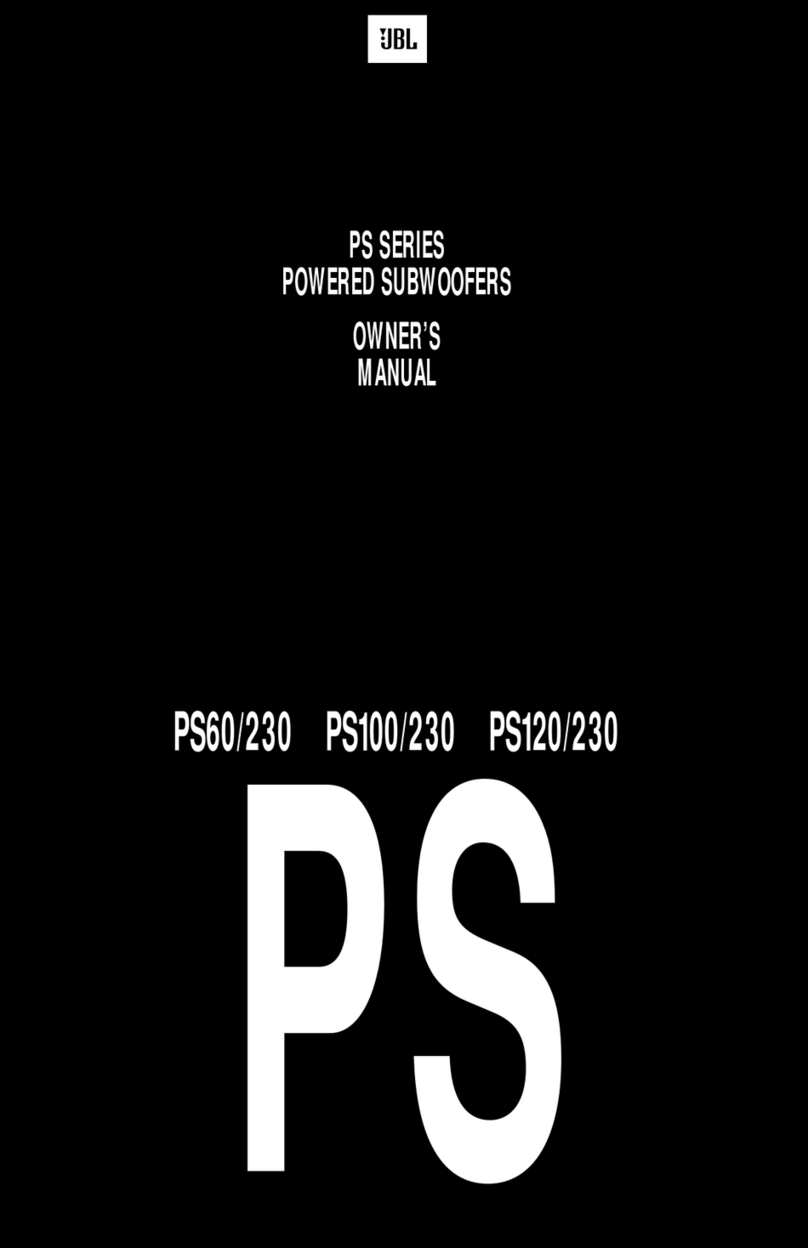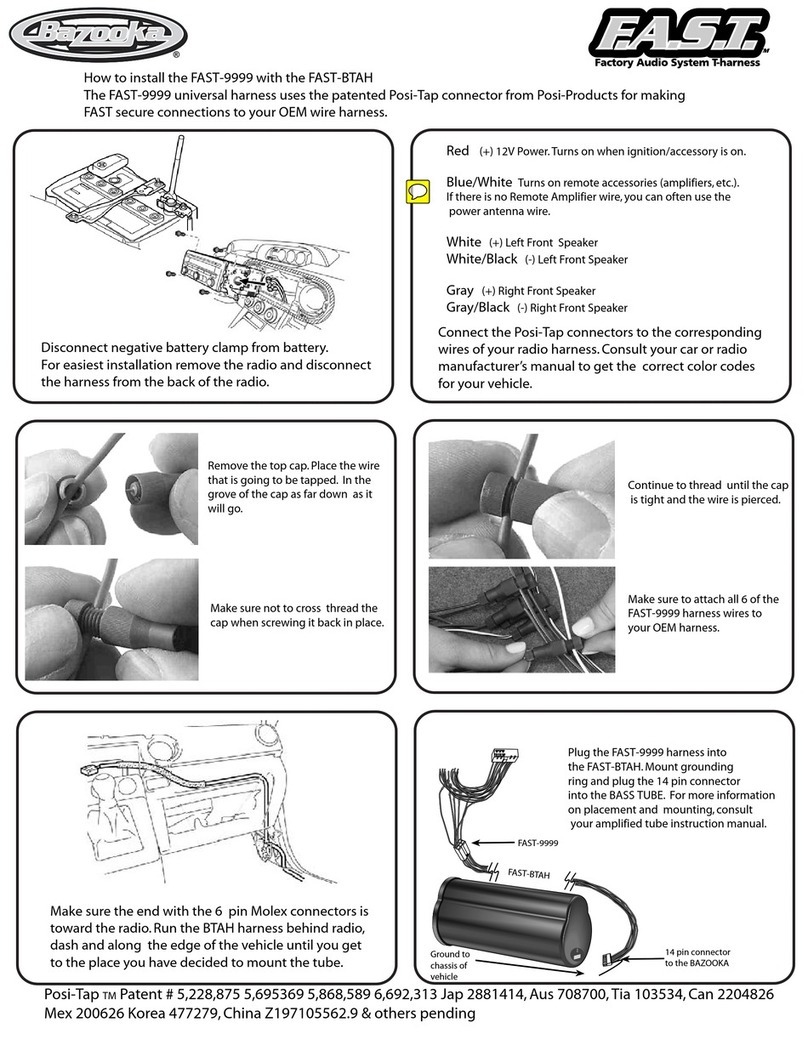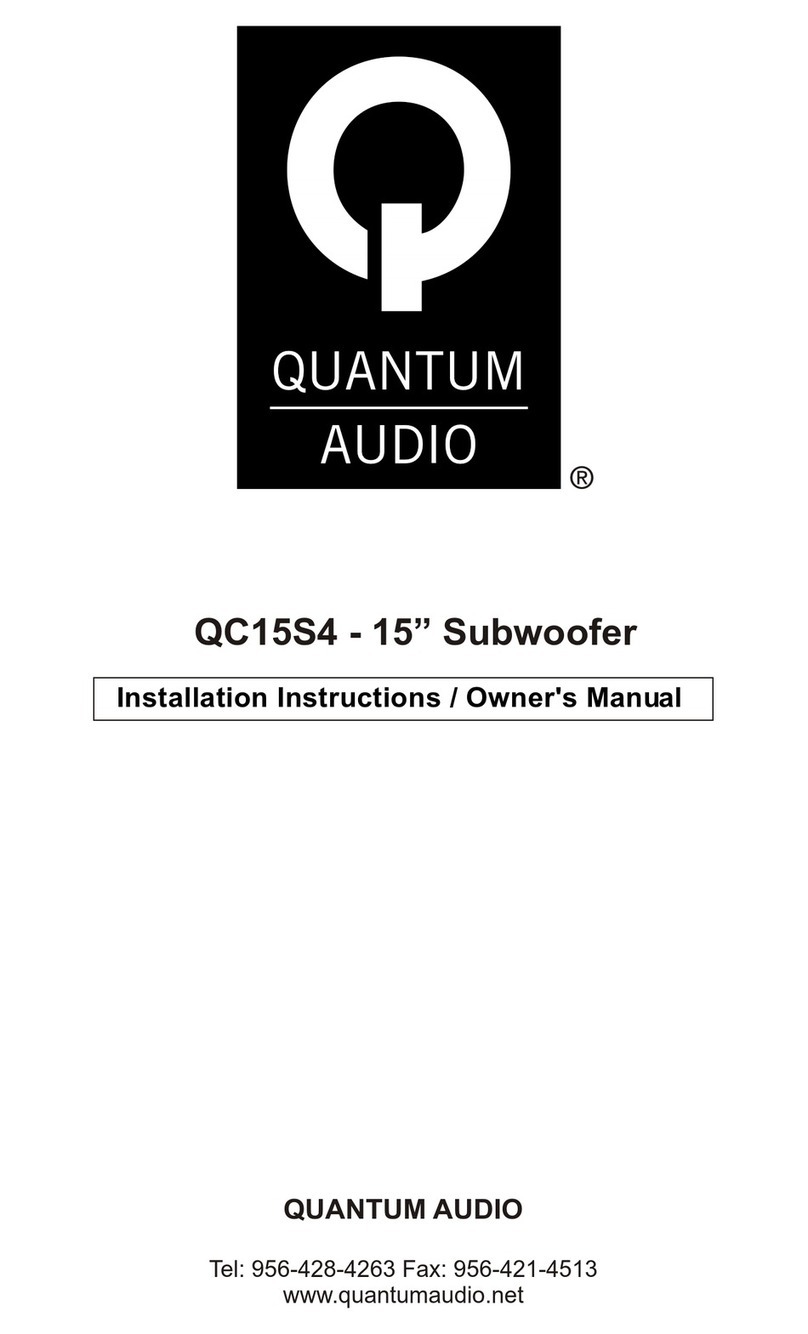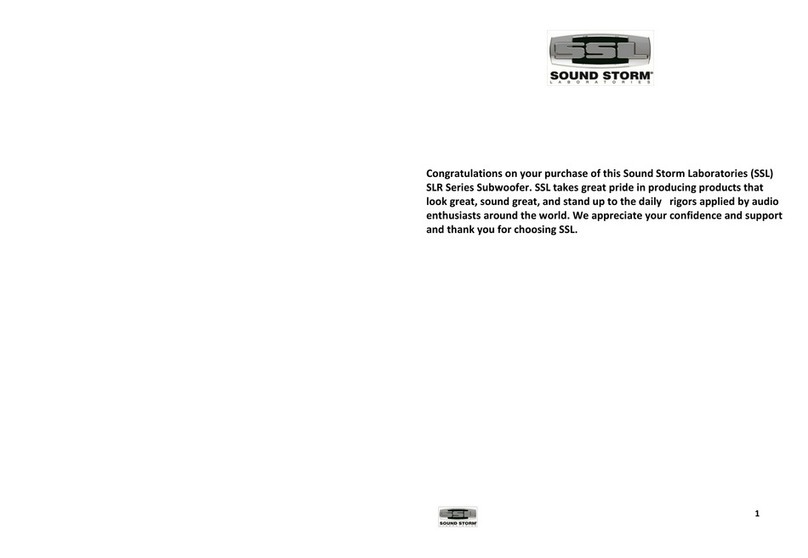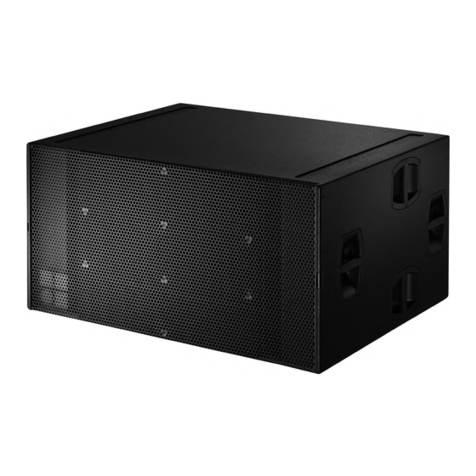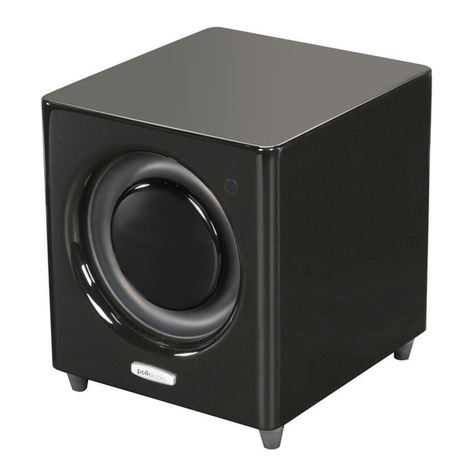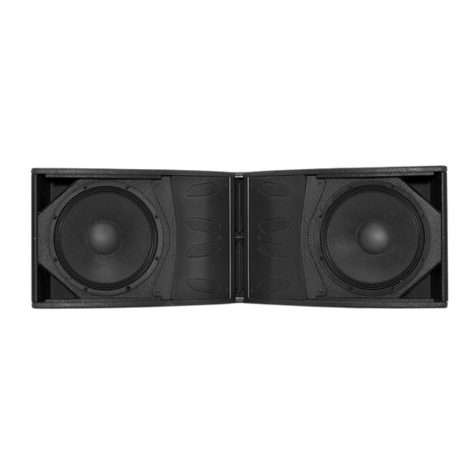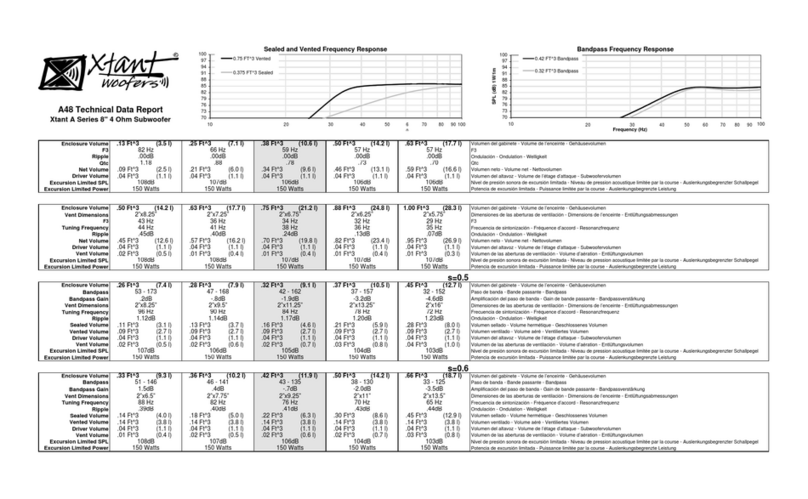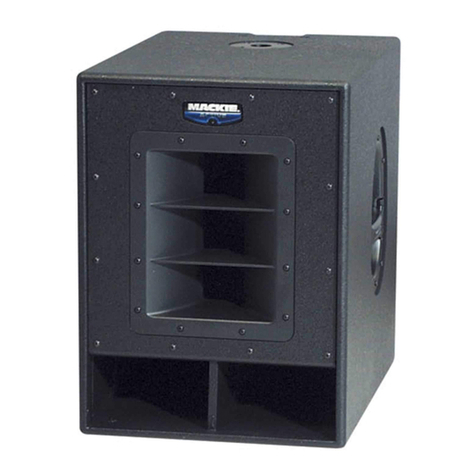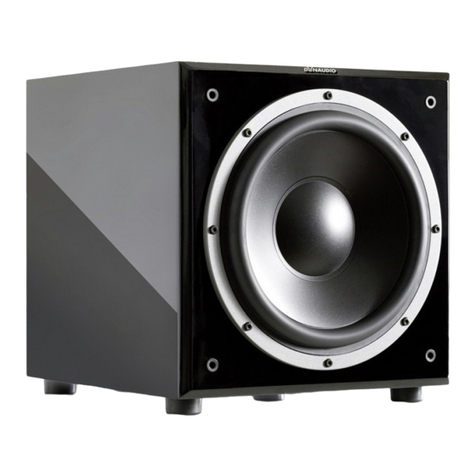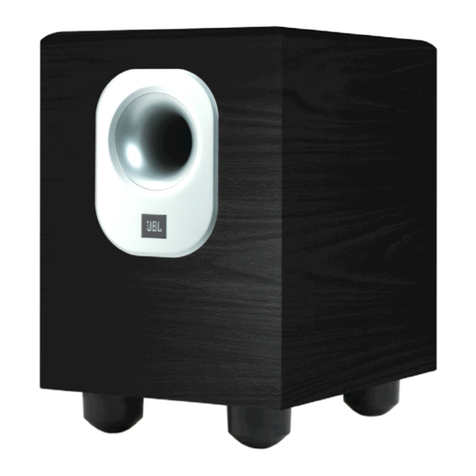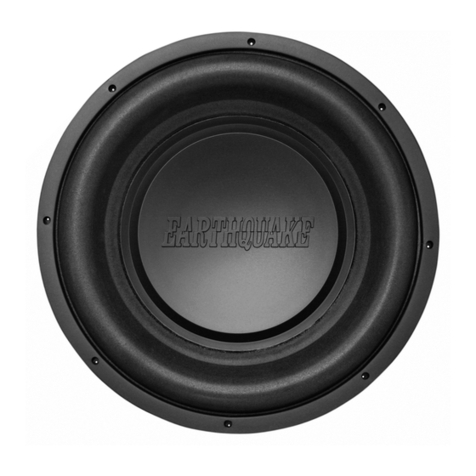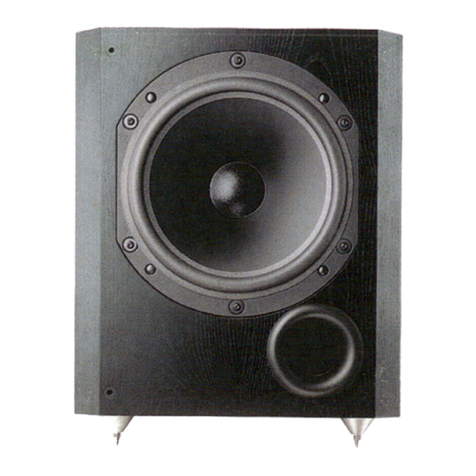Formula F-12 User manual

SPECIFICATIONS
Woofer Size
12˝ Injection-Molded Long Throw Woofer
Power
475 Watts Dynamic Peak Output
(150 Watts RMS Continuous)
MAX Acoustic Output
115 dB SPL
Frequency Response
25Hz - 200Hz (+/- 3dB)
Crossover Frequency Range
40Hz - 180Hz
Enclosure Type
Vented
Dimensions
17˝ H x 15˝ W x 171/2˝ D
Shipping Weight
42 lbs. (19 kg.)
Limited Warranty
5years parts and labor
(excludes sustained cosmetic damages)
OWNER’S MANUAL
Model F-12
12˝ Powered Subwoofer
a Company

The lightning flash with arrowhead symbol within an equilateral triangle is intend-
ed to alert the user to the presence of uninsulated “dangerous voltage” within the
product’senclosure that may be of sufficient magnitude to constitute arisk of
electric shock to persons.
Le symbole éclair avec point de flèche à l’intérieur d’un triangle équilatéral
est utilisé pour alerter l’utilisateur de la presence à l’intérieur du coffret de “volt-
age dangereux” non isolé d’ampleur suffisante pour constituer un risque d’éléc-
trocution.
The exclamation point within an equilateral triangle is intended to alert the
user to the presence of important operating and maintenance (servicing) instruc-
tions in the literature accompanying the product.
Le point d’exclamation à l’intérieur d’un triangle équilatéral est employé pour
alerter les utilisateurs de la présence d’instructions importantes pour le
fonctionnement et l’entretien (service) dans le livret d’instruction
accompagnant l’appareil.
NO USER SERVICEABLE
PARTS ARE INSIDE.
1. Read Instructions — Read all the safety
and operation instructions before operating
the F-12.
2. Retain Instructions — Keep the safety
and operating instructions for future reference.
3. Heed Warnings — Follow all warnings
on the subwoofer and in these operating
instructions.
4. Follow Instructions — Follow all
operating and other instructions.
5. Water and Moisture — Do not use the
subwoofer near water — for example, near a
bathtub, washbowl, kitchen sink, laundry tub,
in a wet basement or near a swimming pool.
6. Heat — Locate the subwoofer away from
heat sources such as radiators, or other
devices that produce heat.
7. Power Sources — Connect the unit only
to a power supply of the type described in
these operation instructions or as marked on
the subwoofer and amp.
8. Power Cord Protection — Route power
supply cords so that they are not likely to be
walked upon or pinched by items placed upon
or against them, paying particular attention to
cords at plugs, convenience receptacles, and
the point where they exit the subwoofer.
9. Object and Liquid Entry — Do not drop
objects or spill liquids into the inside of the
subwoofer.
10. Damage Requiring Service —
Subwoofer should be serviced only by qualified
service personnel when:
A. Sub’s amp power-supply cord or the plug
has been damaged; or
B. Objects have fallen, or liquid has spilled
into the subwoofer; or
C. Subwoofer has been exposed to rain; or
D. Subwoofer does not appear to operate or
exhibits a marked change in performance; or
E. The subwoofer has been dropped, or its
chassis damaged.
11. Servicing — Do not attempt to service
the subwoofer beyond those means described in
this operating manual. All other servicing should
be referred to the qualified service personnel.
12. To prevent electric shock, do not
use the subwoofer’s polarized plug with
anextension cord, receptacle or other
outlet unless the blades can be fully
inserted to prevent blade exposure.
Pour préevenir les chocs électriques ne pas
utiliser cette fiche polariseé avec un prolonga-
teur, un prise de courant ou une autre sortie de
courant, sauf si les lames peuvent être insérées
à fond sans laisser aucune pariie à découvert.
13. Grounding or Polarization — Do not
defeat the grounding or polarization of the
subwoofer.
14. Internal/External Voltage Selectors —
Internal or external line voltage selector switches,
if any, should only be reset and re-equipped with
aproper plug for alternate voltage by a qualified
service technician.
This apparatus does not exceed the Class
A/Class B (whichever is applicable) limits for
radio noise emissions from digital apparatus as
set out in radio interference regulations of the
Canadian Department of Communications.
ATTENTION — Le présent appareil
numérique n’émet pas de bruits
radioélectriques dépassant las limites applica-
bles aux appareils numériques de class A/de
class B (selon le cas) prescrites dans le règle-
ment sur le brouillage radioélectrique édicté
par les ministere des communications du
Canada.
WARNING — To reduce the risk of fire or
electric shock, do not expose this compo-
nent to rain or moisture.
TABLE OF
CONTENTS
UNPACKING . . . . . . . . . . . . . . . . . . . 3
F-12 AMPLIFIER PANEL TOUR . . . . . 3
PLACEMENT . . . . . . . . . . . . . . . . . . . 4
SUBWOOFER CONNECTION . . . . . . . 5
INITIAL LISTENING TESTS . . . . . . . . 7
TROUBLESHOOTING /SERVICE . . . . . 7
WARRANTY . . . . . . . . . . . . . . . . . . . . 8
F-12 SAFETY INSTRUCTIONS
2

The F-12 has been meticulously designed
and tested to insure high performance, dura-
bility and longevity.
This manual is designed to take you step-
by-step through the setup and operating
process. This procedure is not difficult, but
it IS slightly different than setting up a line
level component such as a cassette deck or
CD player. Reading this manual carefully will
insure that you get maximum performance
from your subwoofer.
UNPACKING
Remove the subwoofer from its packing
carefully and inspect it for any shipping
damage. If you discover damage, contact
your dealer immediately.
If possible, save the carton and internal
packing. It’s the best possible protection for
your subwoofer if you need to move it or
return it for service.
Keep your sales receipt in a secure
place. It will establish the duration of
your warranty. It is also good for insur-
ance purposes in case anything happens to
your stereo system.
Congratulations on your purchase of a
Formula F-12 powered subwoofer. It will give
your stereo system unparalleled low frequency
output.
Bass frequencies are critical to realistic
sound reproduction. After you’ve hooked up
your subwoofer, you’ll discover just how
much “punch” and depth you’ve been miss-
ing. No matter what kind of music or videos
you listen to...whether you listen to it loud
or soft, you’ll experience sound that’s richer
and fuller. Bass guitar and string bass will
have more impact. You’ll be able to FEEL as
well as hear percussion – just the way you
would at a live performance. If you have an
audio/video system, movies will come alive
with thunderous sound effects that were
never possible without the F-12.
The F-12 is a self-powered subwoofer
that frees your receiver or power amplifier
from the power demands of reproducing
very low frequencies. To do this, the F-12
incorporates its own built-in crossover
system that automatically “assigns” higher
frequencies to your main speakers and lower
frequencies to its own power amplifier,
contained within the subwoofer enclosure.
DRAWING 1 - Amp rear panel
1.POWER INDICATOR. When the amplifier
is ON, this indicator will be green. When the
amplifier is in the STANDBY mode, as men-
tioned in item 2, this indicator will be red.
2. POWER/AUTO ON SWITCH. This toggle
switch turns the subwoofer on and off.
When the switch is in the ON position, the
amplifier will stay on as long as the switch
remains in that position. When this switch is
in the AUTO position, the amplifier will stay
turned on as long as a signal is being fed to
the subwoofer amplifier. 15 to 20 minutes
after you stop playing music or a video, the
amplifier goes into STANDBY mode – see (1).
When you again begin to play music or a
video, the amplifier will automatically turn on.
3. PHASE SWITCH. This switch is used to
set the subwoofer’s phase to either normal
“0º” or reverse “180º” (out of) phase.
Once you determine the placement of the
subwoofer you will need to try both positions
of this switch for the best bass output for your
listening position. The physical location of
your subwoofer and main speakers determines
the phase setting that will sound best at your
main listening position. If this requires using
the “180º” mode, don’t worry, there is nothing
“abnormal” about it.
4. VOLUME CONTROL.Rotating this
knob clockwise increases the output level of
the subwoofer.To start out, make sure that
the VOLUME is turned all the way down
(fully counterclockwise). Later, after some
initial listening tests, you can adjust the vol-
ume to your own tastes. However,care
should be taken not to overdrive the sub-
woofer to the point of audible distortion.
5. CROSSOVER FREQUENCY CONTROL
This control determines what lower part of
the frequency spectrum will be reproduced
by the subwoofer and what higher parts will
be handled by your main speaker. It is a
“crossover” control. Rotating the knob sets
the point where all lower frequencies will be
handled by the subwoofer and all higher fre-
quencies will be routed to your main stereo
speakers.
As a starting point, set the control around
80 Hz. if you are using left and right tower
speakers, 100 Hz. with bookshelf speakers,
and 120 Hz. with small mini-speakers.
Note: If you are using a Dolby Digital
type receiver, the subwoofer crossover
control does not work. You must
set the crossover frequency in your
F-12 AMPLIFIER
PANEL TOUR
Before actual setup, you should familiarize
yourself with the connections on the back
of the F-12, as shown in Drawing 1.
3
10
11
9
12
3
4
5
6
7
8

Away from walls:
Normal bass
Against walls:
More bass
In Corner:
Most bass
Away from walls:
Normal bass
Against walls:
More bass
In Corner:
Most bass
PLACEMENT
Positioning Your F-12
The subwoofer operates at low bass
frequencies which are essentially omni-
directional. That means you can place the
subwoofer almost anywhere in a room
without compromising the effectiveness of
your main stereo speakers.
Four factors need to be considered:
1) distance from your main speakers;
2) distance from a wall outlet;
3) distance from your receiver; and
4) proximity to walls and corners.
1. Distance from your main speakers.
The best placement for your subwoofer is
on the same wall as the main speakers, espe-
cially if you are matching up with small book-
shelf speakers. With tower speakers, side wall
or rear placement is also acceptable.
2. Wall outlet. Since the subwoofer re-
quires AC power, it must be placed within 10
feet of a wall outlet. We don’t recommend
extending that range with an extension cord.
3. Connections to your receiver,
integrated amplifier or preamplifier. If
your receiver or integrated amplifier does
not have a subwoofer output or LFE output
(see next page), setup between the receiver
and subwoofer will be made with speaker
wire. You can basically place the subwoofer
anywhere in a normal-sized room.
4. Proximity to walls and corners.
Physical placement of the subwoofer will
have a definite impact on the frequency
response and the perceived amount of
subwoofer bass output. Because low fre-
quencies have long wavelengths, they are
influenced by proximity to a boundary such
asawall or floor.
See Drawing 2 below. When you place
the subwoofer well away from a wall, it will
produce bass at a certain level. Move the sub-
woofer close to the wall, it will produce
more output (about 3dB more). Putting the
subwoofer in a corner will increase output
another 3dB (6dB more than when placed
away from walls and corners).
All this technical jargon may sound confus-
ing, but it basically means that you have a num-
ber of options, each of which produces a dif-
ferent amount of bass. For example, if you like
alot of heavy bass, consider putting the sub-
woofer into a corner. If you like smoother,
less obvious bass, move the subwoofer out
into the room. The main thing to remember
is that there is no “right” or “wrong” place to
put the subwoofer (assuming it’s less than 10
feet from a wall receptacle). It all depends on
how much bass you want.
Another reason to experiment – because
low bass waves are very large (up to forty feet
or more across!), they tend to cancel and
reinforce each other,causing places in the
room where there is lots of bass and others
where there isn’tvery much at all. If you walk
around your listening room while playing
music, you’ll probably discover these sorts of
areas where bass is either exaggerated or
reduced.
Incidentally,moving the subwoofer around
won’t affect the stereo imaging of your main
stereo system, so feel free to try various sub-
woofer positions.
4
DRAWING 2 - Subwoofer placement
receiver (check your receiver’s
owner’s manual).
6.SUB IN. This connection is used
to connect the subwoofer to the receiver.
Note: If you use the SUB IN connector,
the RECEIVER TYPE toggle switch
must be in the Pro Logic mode for
the crossover frequency control to
operate.
7. RECEIVER TYPE TOGGLE SWITCH.
You must set this switch to the type of
receiver mode you are using. Note: When
this switch is set to DIGITAL RECEIVER 5.1,
6.1, 7.1, the CROSSOVER FREQUENCY
control (9) does not affect the signal.
8. POWER INPUT. This connector is the
AC power in. Your subwoofer is supplied
with a removable power cord that mates
to this plug.
9. REMOVABLE FUSE HOLDER. By pushing
in and turning counter-clockwise, you can
remove and replace the fuse. Check the
rating on the fuse for proper size of your
unit.
10. FROM RECEIVER. Connects to a
receiver’s speaker terminals. These binding
post, color-coded connectors are used to
hook the subwoofer to another receiver that
may not have subwoofer out or LFE (Low
Frequency Effects) output connections.
11. OUT TO SPEAKERS. If you are using
the F-12 from receiver inputs, you will hook
your main speakers to these binding post,
color-coded connections. They are NOT
used if you are using the LFE (SUB) IN line
level connection.

NOTE: SEE
ITEM 5 AT LEFT
FOR PROPER
RECEIVER TYPE
SWITCH SETTING
F-12 connection
FRONT
SPEAKERS
RIGHT LEFT
REAR
SPEAKERS
RIGHT LEFT
CENTER
SPEAKERS
RIGHT LEFT
SUBWOOFER
OR LFE
OUT
Method A: Line level
hookup steps for receivers
with subwoofer connections
See Drawing 3 below
Note: This connection method is only
for receivers that have a subwoofer or
LFE output. If your receiver does not
have a subwoofer or LFE connection as
shown in Drawing 3, use Method B:
Amplifier wiring hookup steps for
receivers or surround sound receivers
with NO sub output jack.You will need
one line level RCA to RCA connector cable
long enough to reach from your receiver
to your subwoofer location. This should
be available from your B.I.C/Formula
dealer or from radio supply stores.
o1. IMPORTANT: Make sure that ALL
stereo system components including
the subwoofer are turned OFF before
proceeding.
o2. Locate the subwoofer or LFE output
connector on the rear of your receiver
and connect one end of the RCA line level
cord to it.
o3. Route the line cord to the subwoofer
location (trying to minimize areas where it
may be stepped on) and connect the other
end directly to the SUB IN.
o4. Connect your main (and surround
speakers if applicable) to the receiver
according to the receiver’sowner’s manual.
o5. Set the RECEIVER TYPE toggle
switch to the type of receiver you have.
Note: If you are using a Dolby Digital
type receiver, the subwoofer crossover
control does not work. You must set
the crossover frequency in your
receiver (check your receiver’s
owner’smanual).
o6. You are now ready to put your
subwoofer into use.
DRAWING 3 - Hookup for Surround Sound Receiver
with Subwoofer Output
5
SUBWOOFER
CONNECTION
Connecting the
F-12 to a wall plug
The subwoofer draws a moderately high
amount of current. We do not recommend
plugging it into a “convenience” outlet
(switched or unswitched) that is often
found on the back of receivers and other
stereo components.
Instead, connect the F-12 to its own AC
outlet ONLY. See items 8 and 9 in the Safety
Instructions.
Converting Subwoofer to 220-240 Volt Operation
Remove amplifier from subwoofer cabinet. Take out all the screws around the perimeter
of the control plate. Lift out the amplifier, reaching into the cabinet to remove the wire clip
leads from the woofer input terminals.
Locate the power supply voltage-setting connectors. They’re on the PC board that’s
attached between the aluminum heat sinks. At one end of the board the red and black AC
power lines are attached. On that end, on the lower right-hand corner, you’ll see two small
jumper connectors.
Move the connectors. There are four pairs of pins onto which the jumpers can be placed.
For 120-volt operation the jumpers are placed on the two outer pairs of pins. To set up the
amplifier for 220-240 volt input, pull the jumpers straight up off the outer pin pairs and place
them on the inner pairs of pins. (Sometimes the jumpers are held in place with hard yellow
gunk. If they are, carefully cut through the gunk with an X-ACTO knife to free the jumpers.)
Replace the amplifier into cabinet. Reattach the wires to the woofer input terminals.
Orient the amplifier control plate as it was originally, drop it in position, and replace the
screws around the perimeter.

Method B: Amplifier wiring
hookup steps for receivers
or surround sound receivers
with NO sub output jack
See Drawing 4
o1. IMPORTANT: Make sure that
ALL stereo system components
including the subwoofer are turned
OFF before proceeding.
o2. Following the instructions on this
page, strip and twist TWO lengths of
speaker wire that will reach between
your receiver’s left and right speaker
terminals and the subwoofer amp
terminals. Make these two lengths of
wire only as long as is necessary to run
between the two components.
o3. Connect one speaker wire to the
RIGHT “+” and “–” speaker terminals of
your receiver or integrated amplifier.
Then connect the other end of this
speaker wire to the RIGHT “+” and “–”
FROM RECEIVER terminals on the back
of the amp. Use the tips on determining
speaker wire polarity to make sure that
“+” is connected to “+” and “–” is
connected to “–”.
o4. Connect the other speaker wire to
the LEFT “+” and “–” speaker terminals
of your receiver or integrated amplifier.
Then connect the other end of this
speaker wire to the LEFT “+” and “–”
FROM RECEIVER terminals on the back
of the amp. As in step 3, double check
“+” and “–” polarity.
o5. Connect your main/satellite
speakers to the amplifier OUT TO
SPEAKERS terminals.
o6. You are now ready to put your
subwoofer into use.
6
DRA
WING 4 - Hookup for Receivers and
Integrated Amplifiers without a Subwoofer Output
RECEIVER OR INTEGRATED AMPLIFIER
FRONT
SPEAKERS
LEFT RIGHT
COLOR
TOP
SHAFT
STRIPPED
END (1/2˝) WIRE
To connect wire:
1. Unscrew (counter- clockwise)
the top (color portion)
2. Place the stripped metal wire
in the hole in the metal shaft
3. Tighten (clockwise) the top
(color portion) back down on
wire (make sure wire insulation
is not under the plastic nut).
FRONT LEFT
SPEAKER
FRONT RIGHT
SPEAKER
SPEAKER WIRE
CONNECTION DETAIL
loosen
tighten
1/2˝

TROUBLESHOOTING
AND SERVICE
Before returning your subwoofer for ser-
vice, you can save time by checking for a few
problems that are most often encountered.
Power light is not lit. No sound.
1. Is your subwoofer plugged in to a live
AC wall socket?
2. Is the power cord firmly plugged into
the subwoofer amp power input connector?
(See Power Input, Drawing 1, #8)
3. Is the power switch on?
4.Has the subwoofer overheated and shut
off temporarily?
5. Is the fuse OK?
Nosound from either set of
speakers.
1.Are your other components turned on?
2. Is the receiver or preamp set to the
appropriate input and is that sound source
playing?
3. Do you have an unconnected tape
monitor selected?
4. Is the subwoofer correctly connected to
your receiver, preamplifier or integrated
amplifier and turned on?
Sound comes from main
speakers but not subwoofer
1. Is the subwoofer turned on (power
light in the green mode) and VOLUME
control turned up?
2. Check the speaker connections for small
strands of wire touching both terminals.
3. Some digital receivers only send a sub-
woofer out signal when in the movie or digital
mode. In the 2 channel (stereo music) mode,
no subwoofer out signal is sent to the sub-
woofer. You may need to set your main speak-
ers to “small” mode in your receiver setup to
get the receiver’s subwoofer output to turn
on. Check your receiver’s owner’smanual for
subwoofer operation.
4. For digital receivers – make sure
the subwoofer is “ON” and the subwoofer
level is set to “0dB” or greater.
Sound comes from the subwoofer
but not your main speakers
•confirm that the power amplifier is
turned on.
•check the RCA patch cord
•check the speaker wire connections
between the power amplifier and
main or satellite speakers.
Bass is muffled or weak
1. Check speaker wire polarity of all
connections.
2.Reposition your subwoofer. At some
points in the room, its output may be can-
celled by the geometry of the room. Moving
the subwoofer can eliminate this problem.
Please refer to Page 2, #10 in the Safety
Instructions for conditions that ALWAYS
require service by qualified personnel.
If you have tried all the above and
still cannot get the subwoofer to operate
properly, consult Tech Support at
1-877-558-4242(Ext. #2).
B.I.CAmerica
925 N. Shepard Street
Anaheim, CA 92806
www.bicamerica.com
Caring for Your F-12
The F-12 enclosure is finished in a very
high quality polymer laminate covering that
is both attractive and excellent protection for
the wood cabinet. Toremove fingerprints,
splatters of diet soda, peanut butter or other
real-world substances that mysteriously seem
to appear on stereo components, use a
damp, soft cloth on the laminate. You may
also use a high-quality furniture polish to
maintain the original luster.
o8b. Change the CROSSOVER FREQUENCY
control (for Dolby Pro-Logic receivers)
to higher and lower settings. If the
CROSSOVER FREQUENCY control is set too
high, you’ll start to hear low midrange
(voices and instruments) through it. This
will negatively affect the stereo imaging of
your main speakers. Back the CROSSOVER
FREQUENCY setting off until you hear only
bass from the subwoofer. If the CROSSOVER
FREQUENCY control is set too low, you
simply won’t get much output from the
subwoofer. Move it back closer to 80Hz.
o9. After you are satisfied with the output
of your subwoofer, you can make all your
volume settings through your receiver’s volume
control. The only time you might want to
re-adjust the sub amp’s VOLUME is when
you encounter a musical selection that has
abnormally low – or high – bass.
You can leave the subwoofer turned on
and in AUTO mode when not in use. It does
not draw much power in this state and will
be ready to add low bass the moment you
begin to play music. The subwoofer will
automatically go into STANDBY mode after
10 to 20 minutes, when no music is playing.
If you’re not using your stereo system
for a long period of time (such as when
you’re on vacation), unplug it from the AC
wall outlet.
7
INITIAL
LISTENING TEST
It’s now time to test the F-12
subwoofer in your listening environment.
o1. Double-check all connections.
o2. Make sure that the volume controls
on both the subwoofer and your receiv-
er/integrated amp/preamp are turned all
the way down (fully counterclockwise).
Set the PHASE switch to normal. Set the
CROSSOVER FREQUENCY knob to 80 Hz.
Set the SUB IN switch to the type of receiver
mode you will be using.
o3. Turn on your stereo system. THEN
turn on the subwoofer. Confirm that the
subwoofer’sgreen POWER indicator is
glowing. If it isn’t, check the power
connections between the subwoofer and
the wall socket.
o4. Play a musical selection that you are
familiar with. Pick a song that has regular
low bass beats. Advance the receiver/inte-
grated amp/preamp’s volume control up to
anormal listening level. If you don’t hear
sound through your main speakers, turn off
the system and check connections. Also
consult the troubleshooting tips.
o5. If sound is coming out of your main
speakers, turn the sub amp’s VOLUME
control clockwise until you hear noticeable
additional bass. If you don’t hear bass by
the time you have advanced the subwoofer’s
VOLUME control halfway,turn off the sys-
tem and check connections. Also consult
the troubleshooting tips.
o6. Adjust the sub amp’sVOLUME control
until you are satisfied with the amount of
bass. You may want to try several different
movies, tapes, compact discs or DVDs
while determining how high to adjust the
VOLUME. The amount of bass varies from
disc to disc and between different types of
music.
o7. While playing music, move the sub-
woofer around, in and out of corners, clos-
er and farther from the wall, etc. as much
as the power cord and other connections
will allow.
o8. Now that you have adjusted the
quantity of bass via the volume, it’s time to
work on the quality of the bass with the
CROSSOVER FREQUENCY control, PHASE
switch – and experimentation with the
subwoofer room position.
o8a. Have someone change the PHASE
switch back and forth from 0º to 180º while
you sit in the main listening position. Leave
the switch in the position where you like the
bass most.

WARRANTY
INFORMATION
Wesuggest that you read the LIMITED
WARRANTY completely to fully understand
your warranty/service coverage. Be sure
to save the sales receipt in a safe
place. It will be necessary for
warranty service.
If
your subwoofer should require
service, we suggest that you contact the
dealer from whom you purchased it.
If the dealer is unable to take care of
your needs, you may contact us at the
phone number shown at the bottom of
this page. We will then direct you to the
nearest in our national network of
Authorized Warranty Service Centers, or
give you detailed instructions on how to
pack and return the product to us for
prompt action.
F-12 Powered Subwoofer
Limited Warranty
If the
B.I.CSpeaker system proves to be
defective in materials or workmanship
within five years from the date of the orig-
inal customer’s purchase, we will, at our
option, repair or replace the defective
product.
*DISCLAIMER
THE WARRANTY STATED HEREIN IS IN LIEU
OF ALL OTHER WARRANTIES, EXPRESS OR
IMPLIED, INCLUDING MERCHANTABILITY AND
FITNESS FOR PARTICULAR PURPOSE AND ALL
OTHER LIABILITIES AND OBLIGATIONS OF
B.I.CAMERICA, ALL OF WHICH ARE EXPRESSLY
DISCLAIMED. B.I.CAMERICA HAS NOT MADE
AND DOES NOT HEREBY MAKE ANY OTHER
REPRESENTATION, WARRANTY OR COVENANT
WITH RESPECT TO THE CONDITION, QUALITY,
DURABILITY, DESIGN, OPERATION, CAPACITY,
FITNESS FOR USE OR SUITABILITY OF THE
B.I.C/FORMULA ELECTRONIC PRODUCT.
Exclusion of Certain Damages
B.I.CAmerica’s liability for any defective
product is limited to repair or replacement
ofthe product at our option. B.I.CAmerica
shall not be liable for incidental or conse-
quential damages of any kind or character
because of product defects. Some states do
not allow limitations on how long an
implied warranty lasts and/or do not allow
the exclusion or limitation of incidental or
consequential damages, so the above limita-
tions and exclusions may not apply.
This Warranty Does
Not Cover:
Damage caused by abuse, accident,
misuse, negligence, or improper operation.
Products that have been altered or
modified.
Any product whose serial number has
been altered, defaced, or removed.
Normal wear and maintenance.
Damages caused by shipping. (All claims
for shipping damage must be made with the
carrier.)
Warranty Service
Warranty service must be performed by an
authorized service center, usually a B.I.C
America dealer or its authorized agent. You
may obtain a list of authorized service
centers by calling the number below.
All warranty repairs must be
accompanied by the original bill of
sale. No other document is acceptable
or is required.
This warranty gives you specific legal
rights, and you may also have other rights
which vary from state to state.
Due to our continual efforts to improve product quali-
ty as new technology and techniques become avail-
able, B.I.CAmerica reserves the right to revise its
Speaker Systems specifications without notice.
©2013
8
B.I.CAmerica
925 N. Shepard Street
Anaheim, CA 92806
www.bicamerica.com
Contact your dealer for warranty
repair or technical help, or
call
1-877-558-4242 (Ext. #2) for Tech Support.
Table of contents
